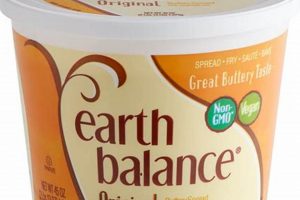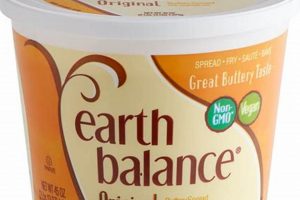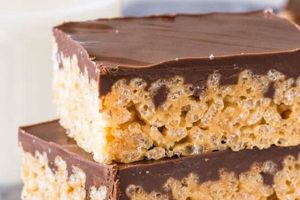A confection combining the rich texture of fudge with the creamy taste of peanut butter, formulated without animal-derived ingredients, is increasingly available. This treat achieves its characteristic sweetness and smooth consistency through plant-based alternatives to traditional dairy and butter. Common ingredients include cocoa, plant-based milk (such as almond, soy, or oat milk), peanut butter, sugar, and sometimes coconut oil to enhance richness.
The growing demand for this product stems from increasing awareness of dietary preferences and ethical considerations. It offers a decadent dessert option for those adhering to plant-based lifestyles and those with dairy allergies or intolerances. Its development reflects a broader trend in the food industry toward providing inclusive and sustainable alternatives without compromising flavor or texture. This confluence of health-consciousness and ethical sourcing has contributed to the product’s popularity.
Understanding the diverse range of recipes, ingredient substitutions, nutritional profiles, and storage considerations related to this type of dessert is essential. Subsequent sections will delve into these aspects, providing a comprehensive guide for both consumers and culinary professionals.
Tips for Creating Superior Plant-Based Fudge with Peanut Butter
Achieving optimal results when crafting plant-based fudge incorporating peanut butter requires attention to specific techniques and ingredient selection. These guidelines will enhance the quality and consistency of the final product.
Tip 1: Ingredient Temperature Control: Ensure that all liquid ingredients, such as plant-based milk and melted cocoa butter, are at room temperature prior to combining. This prevents the cocoa butter from seizing and ensures a smooth emulsion.
Tip 2: Sugar Dissolution: When using granulated sugar, heat the mixture gently and stir constantly until the sugar is fully dissolved before bringing it to a boil. Undissolved sugar can result in a grainy texture.
Tip 3: Peanut Butter Selection: Opt for a natural peanut butter without added oils or sugars. The natural oils in the peanut butter will contribute to the fudge’s richness and prevent an overly sweet flavor profile.
Tip 4: Accurate Temperature Monitoring: Use a candy thermometer to monitor the cooking process. Reaching the correct temperature (typically between 235-240F or 113-116C, the soft-ball stage) is crucial for achieving the desired fudge consistency.
Tip 5: Cooling and Setting: Allow the fudge to cool completely at room temperature before refrigerating. Rapid cooling can lead to cracking or a less uniform texture. Refrigerate for at least two hours before cutting.
Tip 6: Enhancing Flavor Depth: Incorporate a small amount of sea salt or espresso powder to enhance the flavor complexity. These additions will complement the sweetness and nuttiness of the components.
Tip 7: Storage Optimization: Store the fudge in an airtight container in the refrigerator. This will prevent it from drying out and maintain its texture for up to one week.
By adhering to these suggestions, a superior plant-based fudge can be achieved, offering a delectable treat that satisfies both dietary requirements and discerning palates. Mastering temperature control, ingredient quality, and cooling processes is paramount for achieving optimal results.
Further exploration will cover recipe variations and advanced techniques for refining this culinary creation.
1. Ingredients
The composition of ingredients is paramount in achieving the desired characteristics of any confectionery. In the context of plant-based fudge incorporating peanut butter, careful selection and understanding of the components directly impact its flavor, texture, and overall success as a vegan alternative.
- Plant-Based Milk
The type of plant-based milk (e.g., almond, soy, oat, coconut) significantly influences the fudge’s creaminess and subtly alters the overall flavor profile. Each milk imparts a unique nuance; for example, coconut milk contributes richness and a slight coconut flavor, while soy milk offers a more neutral base. The fat content of the milk also affects the fudge’s final texture.
- Sweeteners
Traditional sugar can be replaced with alternative sweeteners like agave nectar, maple syrup, or coconut sugar. These alternatives not only provide sweetness but also contribute unique flavor notes. Agave, for instance, has a mild sweetness, while maple syrup adds a distinct maple flavor. The choice of sweetener impacts the moisture content and overall texture of the fudge.
- Cocoa Powder
The quality and type of cocoa powder (e.g., Dutch-processed, natural) determine the chocolate intensity and color of the fudge. Dutch-processed cocoa, being less acidic, yields a smoother, richer flavor compared to natural cocoa. The amount of cocoa powder also affects the texture, with larger quantities contributing to a drier, more crumbly result.
- Peanut Butter
The selection of peanut butter, whether creamy or chunky, natural or processed, contributes significantly to the texture and flavor. Natural peanut butter, often without added sugars or oils, offers a more intense peanut flavor and a slightly oilier consistency, which can impact the fudge’s firmness. The presence of peanut pieces in chunky varieties adds textural contrast.
The interplay of these components necessitates careful consideration to produce a superior product. Substitution and balancing ingredients carefully can produce various fudge recipes that appeal to a wide variety of tastes. The specific ratios and interactions define the distinctive qualities, making the choice and careful combination of components a crucial aspect of its creation.
2. Texture
Texture is a defining characteristic of food products, significantly impacting consumer perception and enjoyment. In the context of plant-based fudge incorporating peanut butter, achieving the desired texture presents unique challenges and opportunities due to the absence of traditional dairy-based fats and proteins.
- Smoothness and Creaminess
The absence of dairy fats necessitates alternative methods to achieve a smooth and creamy texture. Plant-based milks with higher fat content, such as coconut milk, or the addition of ingredients like cocoa butter, can help replicate the mouthfeel of traditional fudge. Emulsification techniques are also crucial to prevent graininess and maintain a homogenous consistency.
- Firmness and Stability
Controlling the firmness of plant-based fudge is essential for structural integrity. Ingredients like cornstarch or tapioca starch can be used to provide binding and prevent the fudge from being overly soft or sticky. Accurate temperature control during the cooking process is also vital to achieve the appropriate sugar crystallization and resulting firmness.
- Peanut Butter Integration
The type of peanut butter used significantly affects the overall texture. Natural peanut butter, with its higher oil content, can contribute to a softer, more pliable texture, while processed peanut butter with added stabilizers may result in a firmer fudge. The distribution of peanut butter throughout the fudge matrix also impacts the final texture, with thorough mixing preventing pockets of dryness or excessive stickiness.
- Graininess and Crystallization
Preventing unwanted graininess due to sugar crystallization is a critical consideration. Maintaining proper sugar-to-liquid ratios and ensuring complete sugar dissolution during the cooking process are essential. The addition of ingredients like corn syrup or invert sugar can also help inhibit crystallization and maintain a smooth texture.
The interplay between these textural elements ultimately determines the quality and appeal of the plant-based fudge. Careful consideration of ingredient selection, processing techniques, and storage conditions is necessary to create a product that replicates the desirable texture of traditional fudge while adhering to plant-based dietary requirements. The successful manipulation of texture is paramount in delivering a satisfying and enjoyable sensory experience.
3. Flavor Profile
The flavor profile represents a crucial aspect of any food product, dictating its consumer appeal and overall success. In the context of plant-based fudge with peanut butter, achieving a harmonious and satisfying flavor profile necessitates careful consideration of ingredient interactions and sensory balance.
- Cocoa Intensity and Bitterness
The type and quantity of cocoa powder used directly influence the chocolate intensity and perceived bitterness of the fudge. Darker, unsweetened cocoa powders contribute a more pronounced chocolate flavor with a higher degree of bitterness, requiring careful balancing with sweeteners. Conversely, lighter cocoa powders offer a milder chocolate flavor but may necessitate adjustments to other ingredients to achieve the desired depth of taste. The selection directly impacts the overall flavor balance and complexity.
- Sweetness and Sugar Balance
Achieving the appropriate level of sweetness is critical to the palatability of this dessert. The selection of sweeteners, whether traditional sugar or alternatives like agave nectar or maple syrup, contributes not only to the sweetness intensity but also to the overall flavor profile. Overly sweet fudge can mask the other flavors, while insufficient sweetness can result in a bland or unappealing product. Balancing the sweetness with other flavor components is paramount.
- Peanut Butter Nuances and Integration
The flavor of peanut butter must be both prominent and integrated harmoniously with the chocolate base. The type of peanut butter, whether creamy or chunky, natural or processed, influences the textural and flavor dimensions. Natural peanut butter often imparts a more intense, slightly oily flavor, while processed varieties may contribute added sweetness or saltiness. Ensuring even distribution and integration of the peanut butter flavor is essential for a well-balanced flavor profile.
- Vanilla and Aromatic Enhancement
The addition of vanilla extract or other aromatic compounds serves to enhance and round out the overall flavor profile. Vanilla contributes a subtle sweetness and aroma that complements both the chocolate and peanut butter notes. Other flavor enhancers, such as a pinch of sea salt or a hint of espresso powder, can further amplify the flavor complexity and create a more sophisticated taste experience. These additions provide depth and nuance to the final product.
The culmination of these flavor elements determines the overall success of plant-based fudge incorporating peanut butter. Balancing the cocoa intensity, sweetness, peanut butter nuances, and aromatic enhancements is crucial to creating a product that delivers a satisfying and memorable taste experience. Careful attention to these details ensures a harmonious and well-defined flavor profile that appeals to a broad range of consumers.
4. Vegan Compliance
Vegan compliance, in the context of plant-based fudge with peanut butter, signifies adherence to a strict set of guidelines prohibiting the use of any animal-derived ingredients or byproducts. This entails careful ingredient sourcing and production methods to ensure the final product aligns with vegan principles.
- Dairy and Egg Exclusion
The primary aspect of vegan compliance is the complete exclusion of dairy milk, butter, cream, and eggs, which are commonly found in traditional fudge recipes. Plant-based alternatives, such as almond milk, coconut cream, or vegan butter substitutes, must be employed to achieve a similar texture and richness without violating vegan ethics. The absence of these animal products is fundamental to fulfilling compliance.
- Gelatin and Animal-Derived Additives
Gelatin, derived from animal collagen, is frequently used in confectionery for its gelling properties. Its exclusion necessitates the use of plant-based alternatives like agar-agar or pectin to provide structure and stability to the plant-based fudge. Additionally, careful scrutiny of all additives and flavorings is required to ensure they are not sourced from animal products. This includes certain food colorings (e.g., carmine) and flavor enhancers.
- Cross-Contamination Prevention
Maintaining vegan compliance also involves preventing cross-contamination during production. This necessitates the use of dedicated equipment and utensils that have not come into contact with animal products. Thorough cleaning and sanitation protocols are essential to ensure that no trace amounts of animal-derived substances contaminate the plant-based fudge. This aspect addresses potential ethical concerns beyond the ingredients themselves.
- Ethical Sourcing and Production
Beyond the absence of animal ingredients, some interpretations of veganism extend to the ethical sourcing and production of ingredients. This may include considerations of fair labor practices, sustainable farming methods, and minimizing environmental impact. While not always explicitly included in formal compliance standards, these factors represent a growing concern for vegan consumers and can influence purchasing decisions.
Achieving and maintaining vegan compliance in plant-based fudge with peanut butter requires diligence in ingredient selection, production processes, and ongoing vigilance. Verification through third-party certification or transparent labeling practices further assures consumers that the product aligns with their ethical and dietary requirements. Successful adherence to these facets reinforces the integrity of the confectionery as a genuinely plant-based alternative.
5. Shelf life
The shelf life of plant-based fudge incorporating peanut butter is a critical factor influencing its commercial viability and consumer satisfaction. Unlike traditional fudge, which benefits from the stabilizing effects of dairy fats and proteins, the plant-based version faces unique challenges that can significantly impact its longevity. These challenges arise from the inherent characteristics of the ingredients used as substitutes. For example, plant-based milks, such as almond or coconut milk, have different moisture contents and fat compositions compared to dairy milk, affecting water activity and potential for microbial growth. Similarly, the absence of dairy fats can alter the fudge’s structure, leading to increased susceptibility to drying out or textural changes over time.
Several factors contribute to the shelf life of this confection. Packaging plays a crucial role; airtight containers and vacuum sealing can minimize exposure to oxygen and moisture, thereby slowing down oxidation and microbial spoilage. Ingredient selection also has a direct impact. Using stabilizers, such as carrageenan or lecithin, can help maintain emulsion and prevent separation, extending the product’s usable life. Proper storage conditions, particularly refrigeration, are essential. Lower temperatures inhibit microbial growth and slow down chemical reactions that can degrade the fudge’s quality. The water activity (Aw) of the product is also a key determinant; controlling Aw through ingredient selection and processing methods is crucial for inhibiting microbial growth and preventing staling. As an example, a commercially produced plant-based fudge, properly packaged and refrigerated, might have a shelf life of 2-3 weeks, whereas a homemade version stored improperly might only last a few days before significant quality degradation occurs.
In summary, the shelf life of plant-based fudge with peanut butter is a complex interplay of ingredient properties, packaging, storage conditions, and processing techniques. Understanding these factors is essential for manufacturers aiming to produce a high-quality, shelf-stable product that meets consumer expectations. Challenges related to moisture content, oxidation, and microbial growth must be addressed through careful formulation and handling to ensure a reasonable shelf life without compromising taste or texture. This understanding also provides consumers with the information needed to properly store and enjoy this specialized dessert.
6. Nutritional content
The nutritional profile of plant-based fudge incorporating peanut butter warrants careful consideration, particularly given its categorization as a dessert item. Understanding the composition of macronutrients, micronutrients, and other bioactive compounds is essential for consumers seeking to make informed dietary choices.
- Macronutrient Composition
The predominant macronutrients consist of carbohydrates, fats, and proteins. Carbohydrates, primarily from added sugars and starches, contribute significantly to the energy content. Fats, derived from peanut butter and plant-based oils, affect both caloric density and satiety. Protein content is generally lower but is supplied by peanut butter and, to a lesser extent, plant-based milk. The ratio of these macronutrients influences the overall impact on blood glucose levels and energy balance.
- Micronutrient Profile
While primarily a source of macronutrients, this confection can also contribute certain micronutrients. Peanut butter provides vitamins such as vitamin E and minerals like magnesium and phosphorus. Cocoa powder contains antioxidants, including flavonoids. The specific nutrient content varies widely depending on the recipe and ingredients used. However, the generally high sugar content often overshadows the benefits derived from micronutrients.
- Caloric Density and Serving Size
Plant-based fudge is typically calorie-dense due to its high sugar and fat content. A small serving can provide a significant number of calories, which is relevant for individuals managing weight or blood sugar levels. Understanding the recommended serving size is crucial for responsible consumption and minimizing potential adverse effects on health.
- Fiber Content and Glycemic Index
The fiber content is generally low, primarily derived from peanut butter and cocoa. This low fiber content, coupled with high sugar levels, results in a relatively high glycemic index. Consequently, consumption can lead to rapid spikes in blood glucose, which is particularly relevant for individuals with diabetes or insulin resistance. The addition of ingredients like oats or chia seeds can increase fiber content, though typically only marginally.
These facets collectively define the nutritional profile of plant-based fudge with peanut butter, highlighting both its potential benefits and limitations. Consumers should be cognizant of these factors and practice moderation in consumption to align with broader health and dietary goals. Comparison with other desserts and snacks provides a more comprehensive perspective on its nutritional merits and drawbacks.
7. Production Methods
Production methods critically influence the quality, consistency, and scalability of plant-based fudge incorporating peanut butter. The techniques employed during manufacturing directly impact factors ranging from texture and flavor to shelf life and vegan compliance. These methods extend beyond simple recipe execution and encompass equipment, process controls, and quality assurance measures.
- Ingredient Preparation and Mixing
The manner in which ingredients are prepared and combined significantly affects the final product. Accurate measurement and pre-processing of ingredients, such as melting cocoa butter or blending plant-based milk, are crucial for consistency. Mixing techniques, including the order of ingredient addition and the speed and duration of mixing, influence the texture and homogeneity of the fudge. Overmixing can lead to a tough texture, while undermixing may result in ingredient separation or uneven distribution of flavor. For example, adding melted cocoa butter to a chilled plant-based milk base without proper temperature control can cause seizing, resulting in a grainy texture. The equipment used, from hand mixers to industrial-scale blenders, also dictates the efficiency and scalability of this process.
- Cooking and Temperature Control
Cooking is a pivotal step in achieving the desired fudge consistency. Plant-based fudge typically requires heating to a specific temperature range (typically between 235-240F or 113-116C, the soft-ball stage) to achieve the appropriate sugar crystallization. Accurate temperature monitoring using a candy thermometer is essential to avoid undercooking, which results in a soft and unstable fudge, or overcooking, which leads to a dry and crumbly texture. Precise temperature control also affects the flavor profile, as excessive heat can cause caramelization of sugars, altering the intended sweetness and introducing burnt notes. Sophisticated cooking equipment, such as temperature-controlled kettles, ensures uniform heating and prevents localized burning.
- Cooling and Solidification
The cooling process is as critical as cooking in determining the final texture and stability. Rapid cooling can cause sugar crystallization, leading to a grainy texture, while slow cooling may result in a soft and sticky product. Controlled cooling environments, such as refrigerated rooms or cooling tunnels, are often employed in commercial production to ensure uniform solidification. The choice of container material also affects the cooling rate; metal pans conduct heat more rapidly than plastic, potentially influencing the crystallization process. Moreover, disturbances during cooling, such as moving the fudge or introducing vibrations, can disrupt the crystallization structure and impact the final texture.
- Cutting and Packaging
The methods used for cutting and packaging impact the product’s presentation, shelf life, and ease of handling. Automated cutting machines ensure uniform size and shape, while hand-cutting may result in variations in portion size. Packaging materials play a crucial role in preserving freshness and preventing contamination. Airtight containers and vacuum sealing minimize exposure to oxygen and moisture, extending the product’s shelf life. The selection of packaging materials also considers branding and marketing requirements, with considerations for labeling, aesthetic appeal, and sustainability.
In summary, the production methods employed in the creation of plant-based fudge with peanut butter are integral to its overall quality and commercial success. Optimizing each stage of the process, from ingredient preparation to packaging, requires a deep understanding of the interactions between ingredients, equipment, and environmental conditions. Careful attention to these details ensures a consistent, high-quality product that meets consumer expectations for taste, texture, and shelf life.
Frequently Asked Questions about Vegan Fudge Peanut Butter
The following section addresses common inquiries regarding plant-based fudge with peanut butter, providing clarity on its composition, characteristics, and considerations for consumption.
Question 1: What distinguishes plant-based fudge with peanut butter from traditional fudge?
Traditional fudge typically includes dairy milk, butter, and sometimes eggs, which are absent in the plant-based version. The latter relies on plant-derived alternatives, such as nut-based milks, cocoa butter, and vegetable oils, to achieve a similar texture and flavor profile.
Question 2: How does the absence of dairy affect the texture of plant-based fudge?
Dairy fats contribute to the smooth and creamy texture of traditional fudge. In plant-based fudge, careful selection of alternative fats, such as coconut oil or cocoa butter, is essential to replicate this texture. Stabilizers may also be used to prevent graininess or separation.
Question 3: Is plant-based fudge with peanut butter healthier than traditional fudge?
The nutritional content varies depending on the specific recipe. While plant-based fudge eliminates dairy, it can still be high in sugar and fat. Individuals concerned about caloric intake or sugar levels should review the nutrition facts panel carefully. A lower environmental impact associated with plant-based ingredients may also factor into health considerations.
Question 4: What are the common plant-based alternatives used in this type of fudge?
Common alternatives include almond milk, soy milk, coconut milk, cashew cream, cocoa butter, vegan butter substitutes, and plant-based protein powders. The specific combination of these alternatives varies across recipes and manufacturers.
Question 5: How does plant-based fudge with peanut butter compare in terms of shelf life?
The shelf life can vary depending on the ingredients and storage conditions. Plant-based fudge may be more susceptible to spoilage or drying out compared to traditional fudge due to the absence of dairy fats. Proper storage in an airtight container, typically in the refrigerator, is crucial for maximizing its shelf life.
Question 6: Are there any potential allergens to be aware of in plant-based fudge with peanut butter?
Yes. Common allergens include peanuts (from the peanut butter), tree nuts (from nut-based milks), and soy (from soy milk or soy lecithin). Individuals with known allergies to these ingredients should carefully review the ingredient list before consumption.
In summary, plant-based fudge incorporating peanut butter offers a plant-derived alternative to traditional fudge, but careful consideration of its ingredients, texture, and nutritional content is warranted. Consumers should pay attention to allergens, storage requirements, and the overall dietary impact of this confection.
Further exploration can involve delving into specific recipes and culinary applications.
Vegan Fudge Peanut Butter
This exploration has detailed the multifaceted nature of plant-based fudge incorporating peanut butter, encompassing its composition, flavor profiles, production methods, and nutritional considerations. The analysis has underscored the importance of ingredient selection, temperature control, and storage protocols in achieving a desirable product that aligns with vegan principles. Factors influencing texture, shelf life, and allergen potential were also highlighted, offering a comprehensive overview of key considerations for both consumers and manufacturers.
As the demand for plant-based alternatives continues to expand, understanding the nuances of confections such as this becomes increasingly relevant. Continued research and development in ingredient technology and processing techniques will likely further refine the quality and availability of plant-based options. This information aims to empower informed decisions regarding both its production and consumption.







